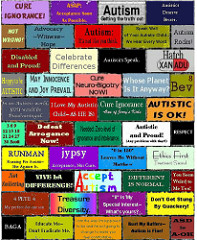This post is a part of Blogging Against Aversives 1-14-08

When a business tries to sell a product or service that no one else has, they might be on the cutting edge of invention or they might have something that no one else wants to sell.
There is only one place in the United States where electrical shocks are doled out repeatedly throughout the day to residents (many of whom are school-age children) as a means of punishment. These two-second shocks are described as feeling like a bee sting, and people to whom this is prescribed must wear the equipment through their waking hours, so such stings to their torso or limbs are unavoidable. According to a recent article in Mother Jones:
Of the 234 current residents, about half are wired to receive shocks, including some as young as nine or ten. Nearly 60 percent come from New York, a quarter from Massachusetts, the rest from six other states and Washington, D.C. The Rotenberg Center, which has 900 employees and annual revenues exceeding $56 million, charges $220,000 a year for each student. States and school districts pick up the tab.
The Rotenberg Center is the only facility in the country that disciplines students by shocking them, a form of punishment not inflicted on serial killers or child molesters or any of the 2.2 million inmates now incarcerated in U.S. jails and prisons. Over its 36-year history, six children have died in its care, prompting numerous lawsuits and government investigations.
JRC is called a “special needs school” because the student-age residents sit at computers every day to do instructional programs. Many of the residents have a variety of psychiatric or learning difficulties, including autism, cognitive disabilities, ADHD, bipolar, post-traumatic stress disorder, schizophrenia or other problems. No psychiatric medications are allowed, and counselling is minimal; whatever the sources of the resident’s problems, the treatment is the same.
The problem inherent in such a single-solution scheme is that it does not address the causes of the resident’s problems, just the inappropriate behavior that results from them. It’s no small wonder that even when people leave, the root problems are not solved, and they continue to have difficulties. Therapeutic approaches need to be individualised — what works for a child with depression and OCD is going to be different than what works for a student with Asperger’s and ADHD. Treatments cannot be designed by diagnostic labels (which are generally descriptive rather than prescriptive) but more by what their individual problems are, and how those problems developed.
The Rotenberg Center does not sell something cutting edge; pain aversives were first trialled in the 1960’s, but have not been used by anyone else, and has been considered to be not within “best practice” for years. Even by the 1980’s, Dr Skinner had an about-face on the use of aversives, and declared that they are not beneficial; although they may temporarily stop a problem behavior, they are not effective in the long term, and the recipient responds by escaping, attacking back, or sinking into the apathy of learned helplessness.
Centers like JRC that bill themselves as solutions for intractable children play upon parents’ fears, and describe problems in exaggerated terms. The premise — and promise — is based upon a giant false dilemma, that there are no other options, it’s the place of last resort, and it’s use their methods or else the child will simply go wild. Parents who have not previously found an effective solution are willing to hand their children over because they are desperate.
JRC is unique because they have cornered the market on a service that no one else wants to sell. That does not make it a good or a necessary thing. I find the whole concept utterly horrifying.
Other posts on JRC:
A Very Painful Problem Certainly, zapping someone with unavoidable, painful electrical stings on bare skin will stop them in their tracks. It stops the self-injury by that default. Punishment will stop people from doing something, at least while the threat of punishment still exists. But it doesn’t help us figure out why the person was hurting themself. It doesn’t teach them how to identify when they are stressed, and to learn different, effective, safe ways of dealing with those stresses. There are students who have been incarcerated at the Judge Rotenberg Center for years past their legal majority. That system does not provide them much in the way of tools to live successfully outside of the institutional environment. …
If hurting yourself is bad, and hurting others is bad, how is it then okay to use intensely painful aversives on someone? We don’t even use things like this in prisons. Why is it deemed “okay” by school districts and courts for children with learning disabilities and emotional problems to be subjected to this kind of treatment? People who injure themselves have a very painful set of problems. But we as a society have an even greater problem. Allowing such treatment to happen and continue is unconscionable.
I Didn’t Ask for That Situations like these really aren’t choices; given more than one option, they are dilemmas or predicaments between bad option and worse option or intolerable option. Some “option” indeed. Sometimes the situation is couched in the language of “choice”, but has nothing to do with the person choosing for their self.
The Crime of Punishment Aversives in the form or corporal punishment (such as the electroshock apparatus used at JRC) teach both the giver and the recipient that aggression and inflicting pain are acceptable and appropriate ways of responding to people when they don’t do what someone else wants them to do. Unfortunately, lots of people have learned this “lesson” all too well … Not only does punishment as behaviour modification set up and maintain coercive power systems, but it also distances teachers and others from their students, and puts them into antagonistic roles, rather than as partners in education (contrary to what many school districts’ mission statements assert).
Making Sense of Rules Being given absolute rules circumvents the learning process, and later when they need to adapt to novel situations, leaves the learner in the lurch, stranded without the knowledge of how to devise new strategies. They only have a limited number of tools in their social toolbox, and little knowledge of how to build new kinds of tools. If we go telling children what to do for their entire lives, then we shouldn’t wonder that they become young adults without the ability to think for themselves and to be responsible without someone monitoring their actions.
Being Unruly People who are heavily invested in punishment and reward systems, invested ego-wise, security-wise, and/or financially-wise (such as the JRC), will try to assert that not using the punishment and rewards to control behaviour will result in gross misbehaviour and chaos. This is a false dilemma; there are other ways of teaching our children.








Mrs. C said,
17 January 2008 at 11:29
Hello. I have posted a link to my blog. This post is well-written and I hope people pay attention.
uphilldowndale said,
16 January 2008 at 13:14
Dreadful, how can it be, how can the states and school districts be funding this?
Casdok said,
15 January 2008 at 13:48
Its barbaric.
lilwatchergirl said,
15 January 2008 at 10:15
Amendment to my earlier statement: there is one situation that I’m aware of when physical punishment of children is legal in this country, and that’s what the law describes as ‘mild smacking’ that leaves no marks. Insitutional physical punishment of children is not legal.
lilwatchergirl said,
15 January 2008 at 10:13
Why the HELL is this allowed???
I am utterly appalled. Corporal punishment of any sort, in any situation, is illegal in this country. Is that not the case in the US? If it is, why is this TORTURE being allowed to continue?
Any ideas from anyone who knows the legality of these things?
Blogging Against Adversives 1-14-08 « Odd One Out said,
15 January 2008 at 2:42
[…] Against Adversives Stirring the Pot The Strangest Alchemy Big Noise Andrea’s Buzzing About Disability Studies, Temple U. Growing Up With a […]